Why Thai Tom Yum Noodle Soup Is the Ultimate Comfort Bowl
Thai Tom Yum Noodle Soup is one of Thailand’s most celebrated dishes, known for its perfect balance of spicy, sour, salty, and slightly sweet flavors. This vibrant soup has captured the hearts of food lovers worldwide, offering a culinary experience that is as invigorating as it is comforting. At Just Thai Recipes, our passion is to bring the bold and beautiful tastes of Thailand into every home kitchen. Founded by Lina, the site shares authentic Thai dishes that reflect not only the flavors but also the traditions behind them.
The About Page reveals our mission: to inspire food enthusiasts to recreate traditional Thai recipes, whether it’s the street-style classics or innovative twists, in their own kitchens. This article will guide you through everything about Thai Tom Yum Noodle Soup – from its origins, ingredients, and health benefits to tips for cooking it perfectly at home. Along the way, we’ll also explore variations like Sukhothai Tom Yum Noodle Soup and provide expert secrets to master the dish. Don’t miss our Thai Coconut Soup with Shrimp for another taste of authentic Thai comfort food.
Table of Contents
Table of Contents
Understanding Thai Tom Yum Noodle Soup
What Makes Thai Tom Yum Noodle Soup Unique?
Thai Tom Yum Noodle Soup is not just another noodle soup; it’s an explosion of flavors in a single bowl. What sets it apart is its harmonious mix of spicy chili heat, tangy lime, and fragrant herbs like lemongrass and kaffir lime leaves. The addition of fish sauce provides a salty depth, while sugar and roasted peanuts add a touch of sweetness and nuttiness. This dynamic flavor profile makes it one of the most loved Thai dishes globally. Unlike many soups, Tom Yum is designed to awaken the palate, offering a combination of tastes that is both refreshing and bold.
Tom Yum Noodle Soup typically includes a savory broth made with pork or chicken bones, rice noodles or egg noodles, and a mix of proteins like ground pork, shrimp, or fish cakes. Fresh vegetables and herbs add vibrancy, while condiments like chili flakes and lime juice allow diners to customize their bowl to their liking. This adaptability has helped the dish remain popular among locals and tourists alike.
Origins and Cultural Significance of Tom Yum in Thailand
The roots of Tom Yum trace back to central Thailand, where it originated as a herbal soup using locally sourced ingredients. The word “Tom” refers to the boiling process, while “Yum” refers to the hot and sour flavor that characterizes the dish. Over centuries, Tom Yum became a culinary icon, symbolizing Thai cuisine’s unique balance of tastes. Traditionally served in family gatherings and special occasions, it’s also widely available as a street food delight.
Tom Yum Noodle Soup specifically evolved as an adaptation of the classic Tom Yum Goong (shrimp tom yum soup), incorporating noodles to make it a complete, hearty meal. Regions like Sukhothai added their twist, giving rise to variations like Sukhothai Tom Yum Noodle Soup, which includes ground pork and a hint of sweetness. Today, this dish not only reflects Thailand’s culinary creativity but also its rich culture of communal dining.
By understanding the origins and uniqueness of Tom Yum, you’ll appreciate why this soup has remained a staple in Thai households and a must-try for anyone exploring the flavors of Thailand.
Print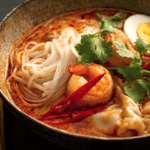
Thai Tom Yum Noodle Soup
- Prep Time: 20 minutes
- Cook Time: 2 hours
- Total Time: 2 hours 20 minutes
- Yield: 4 servings 1x
- Category: Soup
- Method: Stovetop
- Cuisine: Thai
- Diet: Halal
Description
A flavorful and tangy Thai Tom Yum Noodle Soup featuring a fragrant pork broth, tender ground pork, crispy fried garlic, and a perfect balance of sweet, sour, spicy, and savory elements topped with fresh herbs.
Ingredients
- 2 lb pork bones (or substitute chicken bones)
- 5 cloves garlic, crushed
- 5 cilantro roots, smashed to bruise, or 10 cilantro stems
- ½ teaspoon white peppercorns, cracked or ground
- Top half of 2 lemongrass, smashed until broken and cut into 2-inch pieces
- 2 tablespoon water
- 200 g ground pork (or substitute ground chicken)
- 1 teaspoon fish sauce
- 5 cloves garlic, chopped
- 3–4 tablespoon vegetable oil
- 2 tablespoon + 2 teaspoon sugar (2 teaspoon per bowl)
- 2 tablespoon + 2 teaspoon fish sauce (2 teaspoon per bowl)
- 4 tablespoon lime juice (1 tablespoon per bowl)
- ½ cup ground roasted peanuts (2 tablespoon per bowl)
- Roasted chili flakes or regular chili flakes, to taste
- 3 cups (720 ml) pork stock (6 oz/180 ml per bowl)
- 100 g Asian-style fish cakes, thinly sliced (store bought)
- 160 g fresh egg noodles (thin) or another noodle of your choice
- 1 ½ cups bean sprouts
- ½ cup chopped cilantro
- Chili vinegar (optional)
Instructions
- Wash pork bones in cold water and place in a large stock pot. Cover with 3 L cold water, bring to a simmer, and skim off scum. Add garlic, cilantro roots, peppercorns, and lemongrass. Simmer for 1 hour and keep broth hot until use.
- In a small pot, bring water to a boil. Add ground pork and fish sauce, cooking while breaking up chunks until fully cooked.
- In another small pot, add chopped garlic and enough vegetable oil to cover. Fry over medium low heat until golden brown, then transfer immediately to stop cooking. Reserve oil.
- Blanch bean sprouts and fish cakes in boiling water for 7–10 seconds, remove, and divide into serving bowls.
- Cook noodles in the same boiling water until slightly underdone. Drain and divide into serving bowls.
- Top each bowl with 2 heaping tablespoons of cooked ground pork.
- Reheat pork stock to a gentle simmer. Turn off heat, stir in sugar, fish sauce, lime juice, ground peanuts, and chili flakes. Ladle broth over noodles, starting with ¾ cup per bowl, dividing remaining broth evenly.
- Finish with chopped cilantro, fried garlic, and a drizzle of garlic oil. Serve immediately with optional chili vinegar and adjust seasoning to taste.
Notes
- Do not boil the broth vigorously to avoid cloudiness and loss of volume.
- You can keep fried garlic in the oil for soups or drain it to maintain crispiness for other dishes.
- Adjust seasoning per bowl to suit individual preferences.
- Substitute chicken bones and ground chicken for a lighter version.
Nutrition
- Serving Size: 1 bowl
- Calories: 380
- Sugar: 7g
- Sodium: 1050mg
- Fat: 16g
- Saturated Fat: 3g
- Unsaturated Fat: 11g
- Trans Fat: 0g
- Carbohydrates: 38g
- Fiber: 3g
- Protein: 22g
- Cholesterol: 45mg
Keywords: Thai Tom Yum Noodle Soup, authentic Thai soup, spicy noodle soup, tom yum noodles, pork broth soup
Thai Tom Yum Noodle Soup Ingredients Explained
Essential Ingredients for Authentic Flavor
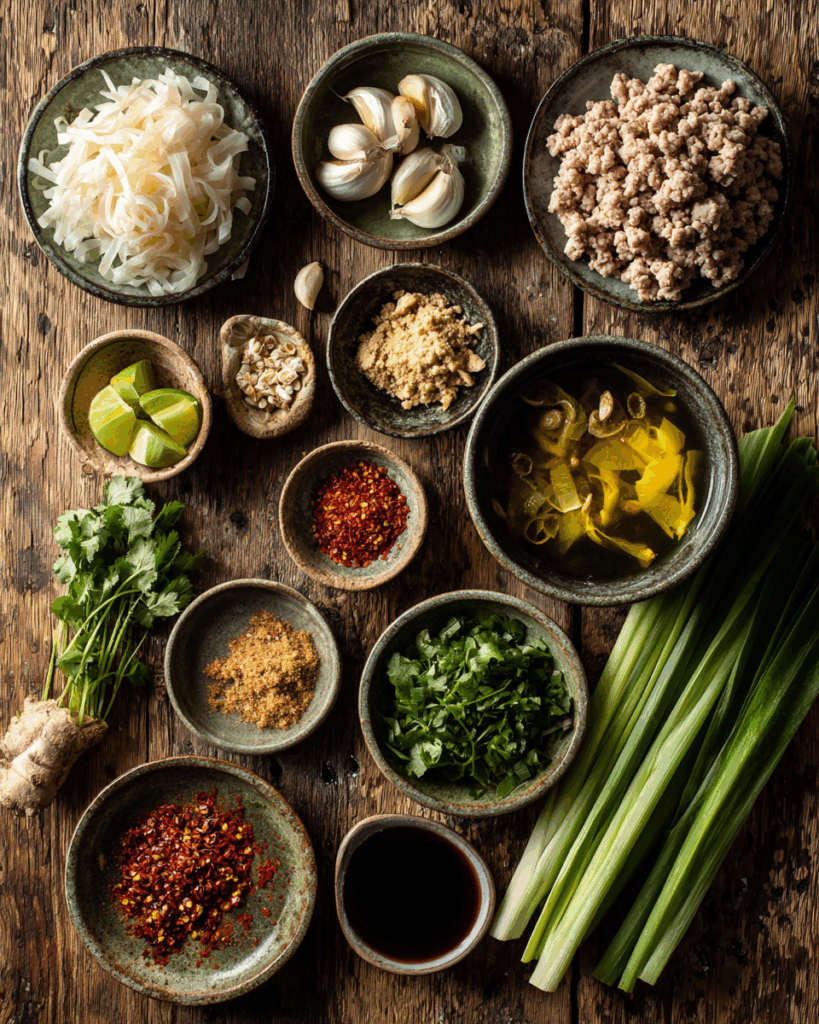
To create an authentic Thai Tom Yum Noodle Soup, using the right ingredients is crucial. The base of this dish starts with a rich pork stock, simmered with pork bones, garlic, cilantro roots, lemongrass, and peppercorns. This broth forms the foundation, carrying the aromatic and savory flavors that make the soup so irresistible. You can substitute chicken bones if pork is not preferred.
Other essential components include ground pork, seasoned with fish sauce to enhance umami. The soup also calls for fish cakes, a common ingredient in Thai noodle soups that adds texture and seafood notes. For the noodles, thin egg noodles are traditionally used, though rice noodles work just as well for a gluten-free option.
Fresh herbs and vegetables play a significant role in achieving the soup’s vibrant character. Bean sprouts add a crunchy freshness, while cilantro brightens the bowl with its aromatic notes. Roasted peanuts provide a nutty, slightly sweet element, and fried garlic contributes a rich, crispy finish. The seasoning mix—lime juice, sugar, fish sauce, and chili flakes—ensures the soup embodies the perfect balance of flavors: spicy, sour, salty, and sweet.
For convenience, some cooks use Tom Yum paste, which combines many of these flavors in one product, making preparation easier without sacrificing too much authenticity.
Variations of Thai Tom Yum Noodle Soup Ingredients
The ingredients of Tom Yum Noodle Soup vary across Thailand. In Sukhothai Tom Yum Noodle Soup, for example, ground pork and a slight touch of palm sugar are often added, giving the dish a mild sweetness. Some modern interpretations include shrimp, chicken, or tofu as alternative proteins, catering to different preferences and dietary needs.
For a more indulgent twist, coconut milk is sometimes added to create a creamy version known as Tom Yum Nam Khon. This variant is richer and less sour but equally delicious. Vegetarians can make a plant-based version by replacing fish sauce with soy sauce and using vegetable broth instead of pork stock.
Exploring ingredient variations allows home cooks to tailor the dish to their taste while still respecting its traditional roots. Looking for inspiration? Try our Homemade Thai Papaya Salad as a side dish to complement the soup’s flavors. You can also check out Pad Thai Salad for another Thai classic that pairs beautifully with Tom Yum.
Additionally, don’t miss our Red Thai Crispy Chicken Curry for another bold and flavorful dish that shares the same balance of spicy and savory as Tom Yum. The ingredients in these recipes often overlap, allowing you to stock up your pantry with versatile staples of Thai cuisine.
How to Make Thai Tom Yum Noodles at Home
Step-by-Step Traditional Thai Tom Yum Noodle Soup Recipe
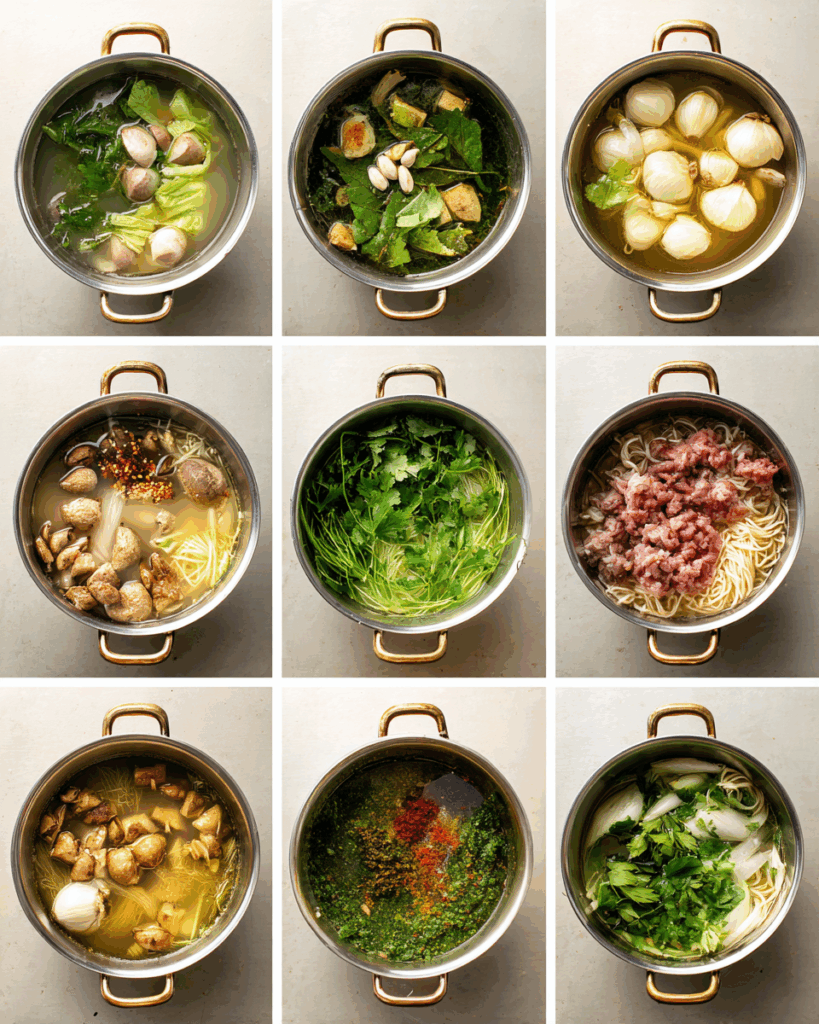
Making Thai Tom Yum Noodle Soup from scratch may seem complex, but the process is quite straightforward once you understand the steps. Here’s how to prepare it like a pro:
1. Prepare the Pork Stock
Start by washing pork bones in cold water to remove impurities. Place them in a large pot with about 3 liters of cold water. Bring to a simmer, not a rolling boil, to avoid cloudiness. Skim off any scum that surfaces. Add garlic, cilantro roots, peppercorns, and lemongrass. Let it simmer gently for another hour. The slow cooking extracts deep flavors, resulting in a clear and aromatic broth. Keep it hot until ready to use.
2. Cook the Ground Pork
In a separate small pot, bring 2 tablespoons of water to a boil. Add ground pork and 1 teaspoon of fish sauce. Stir continuously to break up large chunks until fully cooked. This will be used to top each serving bowl, adding a savory, meaty bite.
3. Prepare Fried Garlic
Heat vegetable oil in a small pot over medium-low heat. Add chopped garlic and fry until golden brown. Immediately transfer to a bowl to prevent burning. This crispy fried garlic is a key finishing touch that enhances the soup’s aroma and flavor.
4. Assemble the Bowls
Blanch bean sprouts and sliced fish cakes in boiling water for 7–10 seconds, then divide them into serving bowls. Cook noodles in the same boiling water until just slightly underdone. Drain and divide noodles between the bowls. Add 2 heaping tablespoons of cooked ground pork to each.
5. Season and Serve
In a medium pot, heat the pork stock until it’s gently simmering. Season with sugar, fish sauce, lime juice, ground peanuts, and chili flakes. Stir to dissolve the sugar completely. Ladle the broth over the noodles—start with ¾ cup per bowl, then divide the remaining broth evenly. Top with fried garlic, garlic oil, and chopped cilantro. Serve immediately, allowing diners to adjust flavors with extra chili vinegar, fish sauce, or lime juice.
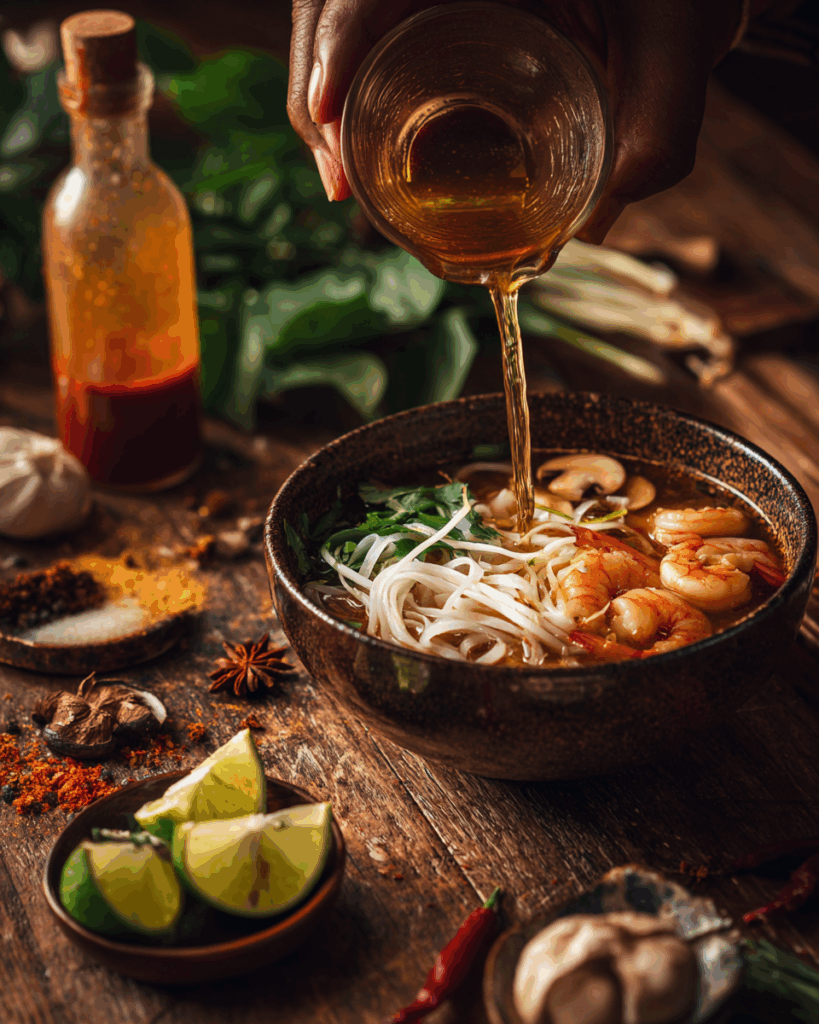
For a visual guide, check out this detailed recipe for Tom Yum Soup Noodles with Tom Yum Paste. This version is perfect if you prefer using Tom Yum paste to simplify the cooking process while still enjoying authentic Thai flavors.
Easy Tom Yum Soup Recipe for Beginners
If you’re short on time or new to Thai cooking, an easy Tom Yum Soup recipe can be your go-to. Instead of making broth from scratch, use store-bought chicken stock and enhance it with Tom Yum paste—a blend of chili, lemongrass, lime, and shrimp flavors. Add noodles, your choice of protein, and finish with lime juice and cilantro. This shortcut still delivers a flavorful and aromatic soup in under 30 minutes.
For a step-by-step guide, you can explore this easy recipe from RecipeTin Eats, which explains how to use readily available ingredients while maintaining the soup’s authentic taste.
For even more tips and variations, visit Hungry in Thailand’s Tom Yum Noodle Soup Guide. It provides insights on different regional versions and how to tweak the spice level to your liking.
These external resources offer excellent additional methods and variations, helping you master Thai Tom Yum Noodle Soup whether you’re a beginner or an experienced cook.
Health Benefits of Thai Tom Yum Soup
Is Thai Tom Yum Soup Healthy?
Thai Tom Yum Soup isn’t just a flavorful dish—it’s also packed with health benefits. The soup is naturally low in calories and fat, especially when prepared without coconut milk. Thanks to its broth base made from pork or chicken bones, it’s rich in minerals like calcium and magnesium, which support bone health. The herbs and spices used, including lemongrass, garlic, and chili, have anti-inflammatory and immune-boosting properties. Lemongrass, for instance, is known to aid digestion and relieve bloating, while garlic supports heart health.
The addition of lime juice provides vitamin C, enhancing the body’s immune defense. Chili peppers, on the other hand, contain capsaicin, which may boost metabolism and improve circulation. Furthermore, the fresh herbs like cilantro add antioxidants, which help fight free radicals. With its balanced combination of protein from pork or seafood, carbohydrates from noodles, and a spectrum of vitamins and minerals from herbs and vegetables, Thai Tom Yum Soup is a wholesome and nourishing meal.
Nutritional Breakdown of Thai Tom Yum Noodle Soup
On average, a serving of Thai Tom Yum Noodle Soup contains about 300 to 400 calories, depending on the protein and noodles used. Here’s an approximate breakdown per serving:
- Calories: 350 kcal
- Protein: 25 g (from pork, fish cakes, or shrimp)
- Carbohydrates: 35 g (from noodles and peanuts)
- Fat: 10 g (from broth and fried garlic oil)
- Fiber: 4 g (from bean sprouts and herbs)
It’s also low in saturated fat when prepared traditionally. The soup’s spices can also help clear nasal congestion and stimulate appetite, making it an excellent choice during cold seasons or when recovering from illness. Unlike many creamy soups, Tom Yum maintains a light consistency while delivering bold flavors and nutrients.
For those following specific diets, adjustments can be easily made. Use low-sodium fish sauce to reduce sodium intake, substitute rice noodles for a gluten-free option, or replace ground pork with tofu for a vegetarian-friendly version. Whether you enjoy it as a starter or a main dish, Thai Tom Yum Soup offers both flavor and health in one bowl.
Tips for Cooking Authentic Thai Tom Yum Noodle Soup
Secrets to Getting the Perfect Balance of Flavors
Cooking authentic Thai Tom Yum Noodle Soup requires a keen sense of balance. This dish thrives on the harmony of spicy, sour, salty, and slightly sweet flavors. To achieve this, follow these secrets:
- Use Fresh Ingredients – Fresh lemongrass, kaffir lime leaves, and lime juice make a significant difference in the soup’s aroma and taste. Avoid bottled substitutes whenever possible.
- Simmer, Don’t Boil – A gentle simmer when making the pork stock ensures a clear, clean broth. Boiling too hard makes it cloudy and bitter.
- Add Seasonings at the End – Fish sauce, lime juice, and chili flakes should be added just before serving. This preserves their bright flavors and prevents bitterness.
- Taste and Adjust – Authentic Thai cooking encourages tasting and adjusting. Don’t hesitate to tweak the balance of lime, sugar, or fish sauce to suit your palate.
- Customize Heat Levels – Use roasted chili flakes for a smoky heat or fresh Thai chilies for a sharper bite. Adjust according to your spice tolerance.
Another pro tip is to prepare the soup in layers. Build flavors step by step, starting with the broth, then add proteins and vegetables, and finish with the seasoning. This layering approach results in a deeper, more authentic taste.
Common Mistakes to Avoid When Cooking Tom Yum Soup
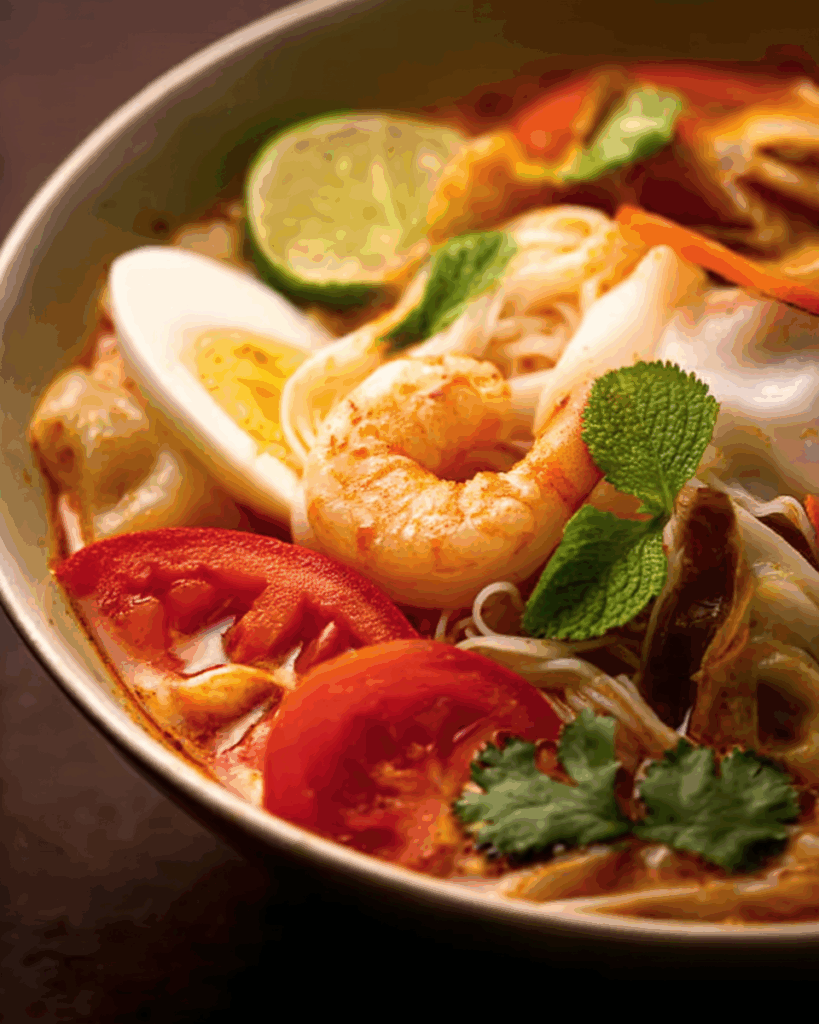
Even seasoned cooks can make errors when preparing Thai Tom Yum Noodle Soup. Here are the common pitfalls and how to avoid them:
- Overcooking the Noodles: The noodles should be slightly undercooked when removed from the boiling water, as they will continue cooking in the hot broth.
- Using Low-Quality Stock: The broth is the heart of the soup. Using a weak or store-bought stock without enhancing it with herbs will lead to a flat-tasting soup.
- Neglecting Garnishes: Fresh cilantro, roasted peanuts, and fried garlic are not just for decoration—they add essential flavor and texture to the final dish.
- Skipping Acidic Elements: Lime juice is critical for the soup’s tangy profile. Without it, the soup becomes dull and heavy.
- Overpowering the Spice: While Tom Yum is known for its heat, too much chili can overshadow other flavors. Balance is key.
Cooking Thai Tom Yum Noodle Soup at home is about patience and precision. Take the time to infuse the broth with herbs and add seasonings gradually. The result is a bowl that captures the essence of traditional Thai cuisine.
By avoiding these mistakes and following the secrets to success, you’ll master Thai Tom Yum Noodle Soup and impress anyone who tastes it. This dish isn’t just food—it’s an experience filled with aroma, spice, and authenticity.
Exploring Variations of Thai Tom Yum Soup
Sukhothai Tom Yum Noodle Soup vs. Traditional Versions
When it comes to Thai Tom Yum Noodle Soup, regional variations play a huge role in shaping the dish’s flavor profile. One of the most notable versions is the Sukhothai Tom Yum Noodle Soup, which hails from the ancient city of Sukhothai. This variation typically features thin rice noodles, ground pork, lime juice, and peanuts, with a slightly sweeter taste compared to the traditional version. Palm sugar is often added to soften the sour and spicy notes, creating a balanced yet unique flavor.
In contrast, traditional Thai Tom Yum Noodle Soup leans heavily on sour and spicy components. The broth is more herbal, featuring the strong flavors of lemongrass, galangal, and kaffir lime leaves. Unlike the Sukhothai version, it doesn’t typically include peanuts or sugar in large amounts, focusing instead on a clear, tangy broth that wakes up the palate.
Both versions are beloved across Thailand, and which one you prefer depends on whether you enjoy a slightly sweet undertone or a sharper, more citrusy kick. Trying both styles at home is an excellent way to experience the regional diversity of Thai cuisine.
Creative Twists: Adding Modern Flavors to Tom Yum
Thai Tom Yum Noodle Soup has evolved beyond its traditional boundaries, inspiring chefs worldwide to create innovative versions. For example, some modern interpretations include adding coconut milk for a creamy texture, transforming it into Tom Yum Nam Khon. This style softens the sourness while introducing a luscious, velvety richness that pairs beautifully with seafood or chicken.
Other creative twists involve substituting the standard pork or fish cakes with shrimp, tofu, or even beef slices, giving the soup a fresh personality. Vegetarian versions swap out the fish sauce for soy sauce or tamari and use vegetable broth instead of pork stock, making the soup accessible to a wider audience.
Fusion cuisine has also embraced Thai Tom Yum Noodle Soup. In some kitchens, it’s served with udon noodles, ramen eggs, or even grilled prawns to add extra depth and flair. These creative takes keep the dish exciting while staying true to its roots.
Despite these innovations, the essence of Thai Tom Yum Noodle Soup remains the same—an aromatic broth, a balance of flavors, and a bowl that offers comfort with every bite. Whether you stick to the classic recipe or experiment with new variations, this soup never fails to impress.
Exploring these versions and modern twists allows you to appreciate how versatile Thai Tom Yum Noodle Soup can be. It’s a dish that adapts effortlessly to different palates, proving why it remains a favorite in Thai cuisine and beyond.
Exploring Variations of Thai Tom Yum Soup
Sukhothai Tom Yum Noodle Soup vs. Traditional Versions

Thai Tom Yum Noodle Soup comes in several regional variations, with Sukhothai Tom Yum Noodle Soup being one of the most distinct. Originating from the Sukhothai region, this version is characterized by its slightly sweeter broth and the use of ground pork, peanuts, and long beans. Unlike the traditional Thai Tom Yum Noodle Soup, which leans heavily on sourness and spice, the Sukhothai version adds a touch of sweetness that balances the bold flavors. The noodles used are usually rice noodles, making it lighter while still satisfying.
On the other hand, the traditional Thai Tom Yum Noodle Soup recipe focuses on a sharper balance of sour lime juice, spicy chili, and savory fish sauce. It typically avoids coconut milk, keeping the broth clear and tangy. The herbs, such as lemongrass and kaffir lime leaves, stand out more in this version.
Both versions use similar Tom Yum soup ingredients like lemongrass, galangal, lime juice, chili flakes, fish sauce, and roasted peanuts, but the proportions and additions vary slightly. Exploring these variations allows you to appreciate how different regions of Thailand put their own spin on this beloved dish.
Creative Twists: Adding Modern Flavors to Tom Yum
Beyond the classic and regional styles, there are numerous creative ways to elevate authentic Thai Tom Yum Noodle Soup. Some chefs experiment by adding coconut milk, resulting in Tom Yum Nam Khon, a creamy variation that softens the heat while enriching the texture. Others swap out pork for seafood, chicken, or tofu, creating lighter or protein-specific versions.
For a quick and convenient alternative, an easy Tom Yum Soup recipe can be made with Tom Yum Paste. This paste is a concentrated blend of herbs, spices, and shrimp flavors that captures the essence of Tom Yum without the need for extensive preparation. Simply dissolve it in broth, add noodles, proteins, and fresh herbs, and you’ll have a delicious soup in under 30 minutes.
Modern cooks also experiment with adding mushrooms, cherry tomatoes, or even a splash of coconut cream to balance the spice. Some recipes incorporate ramen noodles or glass noodles for a fusion twist, proving that Thai Tom Yum Noodle Soup is as versatile as it is flavorful.
When preparing any variation, the choice of Thai Tom Yum Noodle Soup ingredients determines the final taste. Always opt for fresh herbs, quality fish sauce, and freshly squeezed lime juice to maintain the soup’s authentic edge.
Whether you prefer the boldness of the traditional Thai Tom Yum Noodle Soup, the sweetness of Sukhothai Tom Yum Noodle Soup, or the convenience of a Thai Tom Yum Noodle Soup recipe made with Tom Yum Paste, there’s a version to suit every taste. This adaptability is why Thai Tom Yum Noodle Soup continues to be a favorite across the globe.
Serving and Pairing Thai Tom Yum Noodle Soup
Best Side Dishes to Serve with Thai Tom Yum Noodle Soup
When enjoying Thai Tom Yum Noodle Soup, pairing it with the right side dishes can enhance your dining experience. The soup itself is a complete meal, but Thai cuisine thrives on variety and complementary flavors. Some of the best side dishes include:
- Thai Papaya Salad (Som Tam): The crunchy green papaya and tangy dressing provide a refreshing contrast to the warm, spicy broth of the soup.
- Spring Rolls: Crispy vegetable or shrimp spring rolls offer a light, crispy texture that complements the soft noodles and tender pork.
- Thai Fried Chicken: Juicy, crispy, and seasoned with Thai spices, this dish pairs beautifully with the sour and spicy notes of the soup.
- Sticky Rice or Jasmine Rice: While noodles dominate the soup, a small portion of rice can balance the meal, especially for those who prefer milder bites between sips of broth.
Serving side dishes ensures that your table feels like a true Thai feast. Together with Thai Tom Yum Noodle Soup, these sides create a balanced meal full of textures and flavors.
Garnishes That Enhance the Flavor and Presentation
The final touch to any authentic Thai Tom Yum Noodle Soup lies in its garnishes. These not only make the bowl visually appealing but also add layers of taste and aroma. Common garnishes include:
- Fresh Cilantro: Adds a burst of herbaceous freshness that complements the sour and spicy broth.
- Roasted Peanuts: Provide a satisfying crunch and subtle sweetness.
- Fried Garlic: Adds a toasty, aromatic element that enhances every bite.
- Lime Wedges: Let diners adjust the sourness to their preference.
- Chili Flakes or Fresh Thai Chilies: Perfect for those who enjoy an extra kick of heat.
Presentation matters when serving Thai Tom Yum Noodle Soup. Arrange noodles neatly, place proteins and vegetables attractively, and pour the broth gently to showcase the vibrant colors of the soup. Top with garnishes at the very end to keep them fresh and aromatic.
The beauty of Thai Tom Yum Noodle Soup lies in its customizable nature. Each bowl can be adjusted to match individual preferences, from the level of spice to the type of noodles used. Pair it with Thai appetizers or serve it on its own for a satisfying and aromatic meal.
Whether you prepare the traditional Thai Tom Yum Noodle Soup recipe, the Sukhothai Tom Yum Noodle Soup, or a version using Tom Yum Paste, presenting it beautifully and pairing it with classic Thai sides makes the experience truly unforgettable.
Conclusion: Why You Should Try This Delicious Soup
Thai Tom Yum Noodle Soup is more than just a bowl of noodles; it’s a culinary journey that showcases the heart of Thai cuisine. Its harmonious blend of spicy, sour, salty, and sweet flavors makes it a dish that appeals to all senses. The fragrant lemongrass, the zesty lime juice, and the kick of roasted chili flakes work together to create a taste experience that’s unforgettable. Whether you prepare a traditional Thai Tom Yum Noodle Soup recipe with homemade broth or opt for a quick version using Tom Yum Paste, the result is always satisfying and deeply flavorful.
The beauty of authentic Thai Tom Yum Noodle Soup lies in its versatility. You can customize the spice level, choose your preferred protein, and even experiment with variations like Sukhothai Tom Yum Noodle Soup, which adds a touch of sweetness to the mix. Its health benefits, from boosting immunity to aiding digestion, make it a smart choice for anyone who wants a dish that’s as nourishing as it is tasty.
Recreating this soup at home allows you to control every element, ensuring a perfect balance of flavors. Serve it with classic Thai side dishes, and you’ll have a restaurant-quality meal in your kitchen. Don’t miss exploring other Thai favorites to complete your experience. Looking for inspiration? Try our Red Thai Crispy Chicken Curry for another spicy and savory delight. You can also discover great ideas like Pad Thai Salad or enjoy a refreshing side with Homemade Thai Papaya Salad.
In summary, Thai Tom Yum Noodle Soup delivers a bowlful of bold flavors and health benefits, making it a must-try for food enthusiasts. Bring Thailand to your table by preparing this iconic dish and savor every spoonful of its deliciously balanced taste.
Frequently Asked Questions (FAQs)
What is Tom Yum in Thailand?
In Thailand, Tom Yum is a famous soup known for its hot and sour flavors. The term “Tom” refers to the boiling process, while “Yum” signifies the characteristic spicy and sour taste. Traditionally, Tom Yum is prepared as a clear broth with herbs, chili, lime, and fish sauce, often served with shrimp (Tom Yum Goong) or chicken. When noodles are added, it transforms into Thai Tom Yum Noodle Soup, a heartier and more filling version loved by locals and tourists alike. The dish is a staple in Thai cuisine and reflects the country’s passion for bold, aromatic, and balanced flavors.
Is Thai Tom Yum Soup healthy?
Yes, Thai Tom Yum Noodle Soup is considered a healthy dish. Its broth is light yet packed with nutrients, thanks to herbs like lemongrass, which supports digestion, and garlic, known for its immune-boosting properties. The soup is low in fat and calories but rich in protein when made with pork, chicken, or seafood. Fresh vegetables like bean sprouts and herbs add vitamins, antioxidants, and fiber. With minimal use of processed ingredients, this dish offers a nutritious and flavorful option for any meal.
How to make Thai Tom Yum Noodles?
To prepare Thai Tom Yum Noodle Soup, start with a flavorful pork broth simmered with lemongrass, garlic, and cilantro roots. Add noodles, ground pork, and fish cakes, then season the broth with fish sauce, lime juice, sugar, and chili flakes. Finish with roasted peanuts, fresh cilantro, and fried garlic for texture and aroma. For a quicker method, use Tom Yum Paste, which combines essential spices and herbs in a concentrated form. Simply dilute it with broth, add noodles, and garnish to taste. This is an easy way to make the soup while maintaining authentic flavors.
What does Thai Tom Yum Soup taste like?
Thai Tom Yum Noodle Soup offers a distinctive taste that’s both bold and refreshing. The soup combines spicy chili heat, tangy lime, and the herbal aroma of lemongrass and kaffir lime leaves. The balance of sour, salty, and slightly sweet flavors creates a complex profile that excites the palate. When paired with tender noodles, ground pork, and roasted peanuts, the dish delivers a satisfying and layered eating experience.

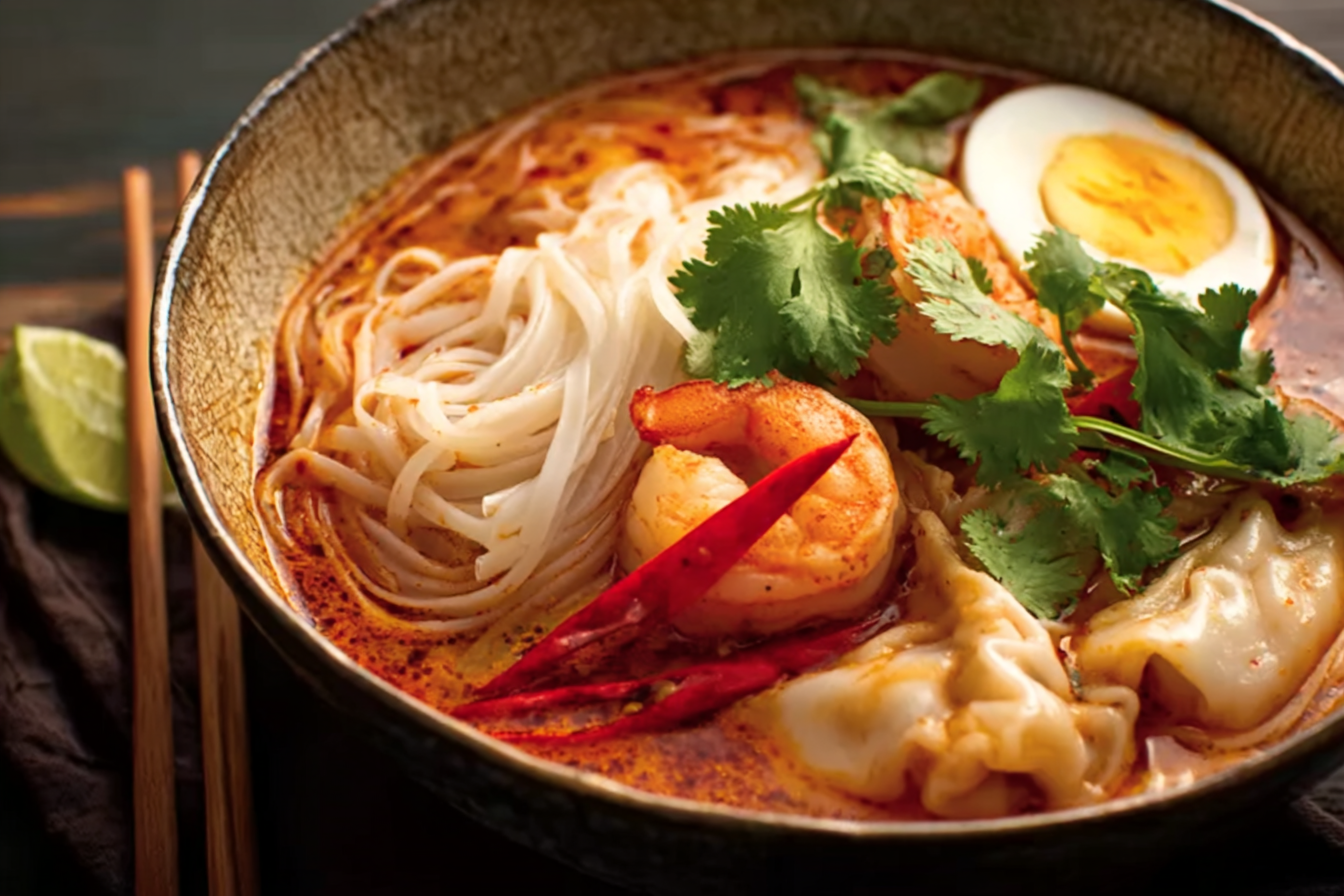
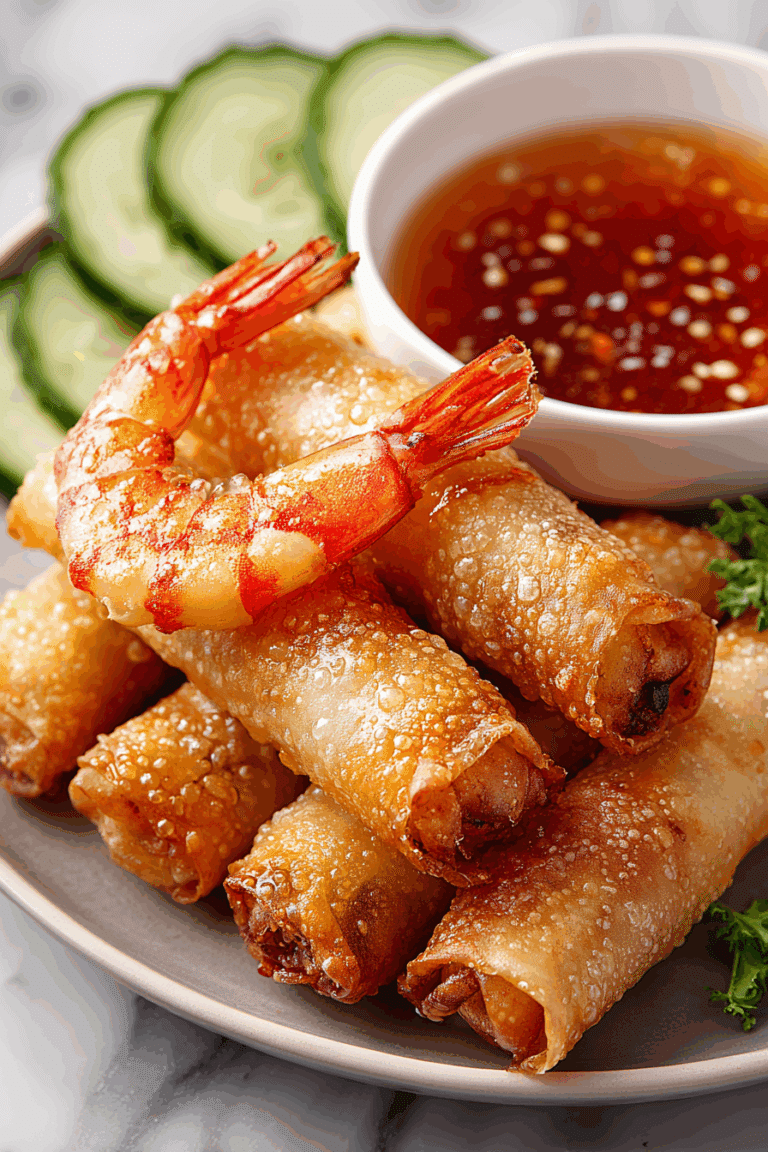



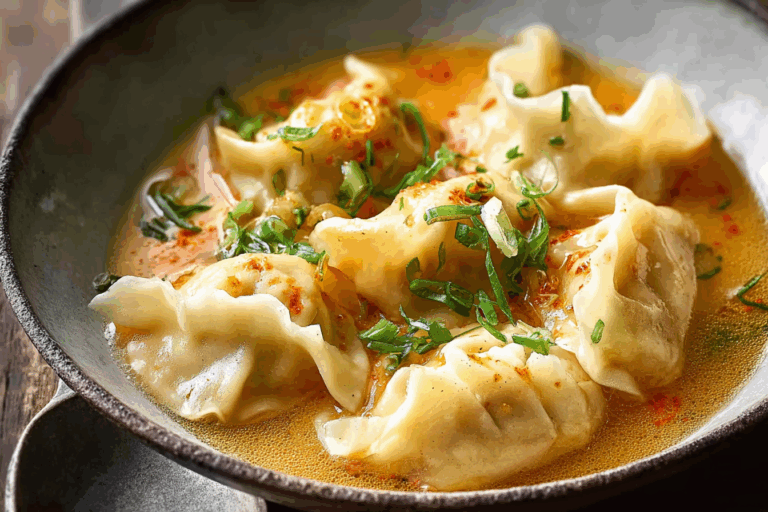

Write more, thats all I have to say. Literally, it seems as though you relied
on the video to make your point. You definitely know what youre talking about, why waste your intelligence on just posting videos to your blog when you could be giving us
something informative to read?
★★★★★
What’s up, every time i used to check webpage posts here in the early hours in the daylight, for the reason that i enjoy to find out more and more.
★★★★★
What i do not understood is if truth be told how you’re no longer actually a lot more smartly-liked than you might be now. You’re very intelligent. You recognize thus considerably in relation to this subject, produced me in my view believe it from numerous numerous angles. Its like women and men are not fascinated unless it is something to accomplish with Girl gaga! Your individual stuffs outstanding. Always care for it up!
I go to see everyday some web sites and sites to read articles, however this webpage offers quality based content.
★★★★★